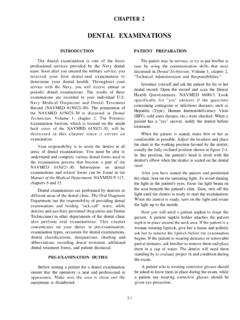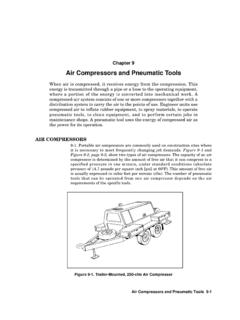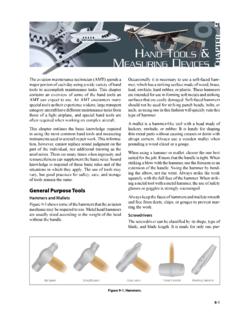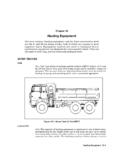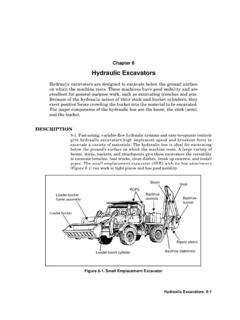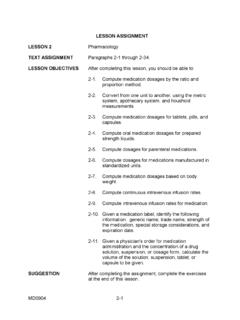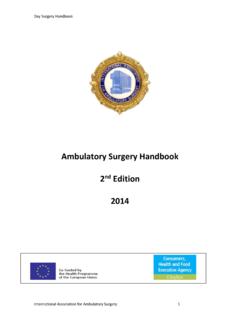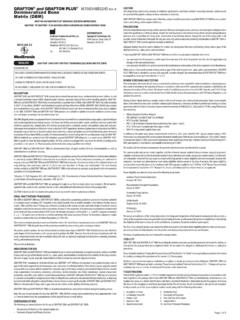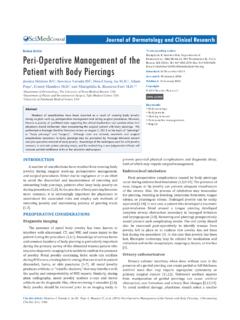Transcription of ORAL SURGERY ASSISTANCE - sweethaven02.com
1 CHAPTER 5 oral SURGERY ASSISTANCEINTRODUCTIONOral SURGERY deals with the surgical treatment orcorrection of diseases, defects, or injuries of the oralcavity, teeth, and adjacent tissues. A sound knowledgeof surgical assisting procedures is essential if you areto be an effective oral SURGERY SURGERY FUNCTIONOral SURGERY provides surgical treatment orcorrection of diseases, defects, or injuries of the oralcavity and facial structures. A wide variety of surgicalprocedures takes place in the oral -maxillofacialsurgery area. Exodontics is the term used to describethe extraction of teeth in oral SURGERY . General dentistsare trained in surgical procedures; however, they maychoose to refer the patient with a more complicatedcase to an oral surgeon who has specialized training inthe area. A maxillofacial surgeon is an oral surgeonwho specializes in the reduction of bone fractures andreconstruction of the maxilla or mandible, andperforms reconstructive ANDCONTRAINDICATIONSB efore a surgical procedure can be done, the oralsurgeon will evaluate each patient's record forindications and contraindications to treatment.
2 Someindications for oral SURGERY include:Carious teeth unrestorable by teeth when endodontic treatment is notindicated or has little chance of of teeth to provide space in the arch fororthodontic without sufficient bone or impacted teeth interferingwith normal teeth that cannot be fragments from prior extractions of of exostosis (overgrowth of bone),such as torus mandibularis and torus fracture or reconstruction of themandible or oral surgeon will also evaluate the patient forpossible contraindications to surgical should be avoided when an activeinfection is present because local anesthesia is difficultto achieve and the infection can spread to other parts ofthe body. Patients suffering from any potentiallyserious disease, such as heart disease, diabetes, andblood disorders, should first be evaluated by aphysician to determine if they can withstand theprescribed treatment.
3 Patients in the early stages ofpregnancy should have the SURGERY postponed untilthey are in the second AND INFORMEDCONSENTE xamination and informed consent are essential todetermine what treatment is required, and provide allrelevant information to the patient to make aninformed decision regarding proposed oral surgeon examines the patient to confirmthe findings of the referring dentist and gather anyother additional information to make treatmentrecommendations. oral surgeons should orderradiographs of the teeth, mandible, maxilla, or otherfacial areas to verify the treatment recommendations ifnot already taken. The radiographs may includeperiapical, extraoral of the skull or facial aspects,panoramic, temporomandibular, and occlusal. Acomprehensive medical history review is essential forthe surgical patient because of the strain SURGERY placeson the body.
4 If there are any questions regarding thepatient's health or ability to withstand SURGERY , thesurgeon should consult with the patient's physicianbefore the examination, the oralsurgeon also discusses appropriate pain-controlmethods for the surgical treatment recommended, andinformed consent with the patient or legal ConsentProviding proper informed consent is an integralpart of appropriate patient-provider relations. Dentalproviders should make every attempt to disclose allrelevant information to the patient or legal guardian inorder for them to make an informed decision regardingany proposed treatment. The Standard Form 522,Request for Administration of Anesthesia and forPerformance of Operations and other Procedures ( ) should be used when informed consent isrequired, including the use of intravenous consciousFigure 5-1. Request for Administration of Anesthesia and for Performance of Operations and Other Procedures, SF or general SURGERY , and certain oral orperiodontal SURGERY procedures.
5 Most routineinformed consent can be easily accomplished duringthe verbal verification of diagnosis and AND ANXIETY CONTROLWhen dental SURGERY is indicated, whether oral orperiodontal, there are several pain and anxiety controlmethods available to make the SURGERY as smooth aspossible and put the patient at ease. The three basiclevels of anesthesia are local, conscious sedation, andgeneral. You should review Dental Technician,Volume 1, Chapter 7, " oral Pharmacology," to helpyou better understand the following informationLocal AnesthesiaThe primary effect of local anesthetic agents is topenetrate the nerve cell membrane and block theconduction of nerve impulses from the point where thelocal anesthetic is active. This produces anesthesia inthe local area. Local anesthesia, using infiltration,nerve block, or a combination of both techniques, isused in SURGERY cases to numb the SURGERY dental SURGERY procedures require two ormore injections of a local anesthetic.
6 For this reason, itis a good practice to include two aspirating syringeswith each instrument setup. This will let you supplythe dentist with a loaded anesthetic syringe for as longas needed with minimum loss of anestheticsolutions are bitter and there is leakage from theinjection sites, you will need to irrigate and aspirate thefluids from the patient's mouth after SedationConscious sedation is a minimally depressed levelof consciousness that retains the patient's ability toindependently and continuously maintain an airway,and respond appropriately to verbal sedation involves using various drugs or acombination of drugs to achieve pain and anxietycontrol while maintaining the patient in a consciousstate at all times. The common routes of administrationof conscious sedation are oral premeditation,inhalation, and intravenous. Local anesthesia isadministrated with all types of conscious AnesthesiaGeneral anesthesia is a controlled state ofunconsciousness accompanied by a partial or completeloss of protective reflexes, including the ability tomaintain an airway independently and respond toverbal commands.
7 General anesthesia renders thepatient unconscious through depression of the centralnervous system, thus eliminating patient cooperationas a factor. The administration of general anesthesia isperformed by an anesthesiologist in the hospitaloperating room. Local anesthesia is also administeredat the treatment SURGERY PROCEDURESW hile there are many oral SURGERY procedures,some are more commonly performed than others. Youshould be knowledgeable of those that are commonlyperformed. In the following paragraphs, we discusssurgical procedures you will need to EXTRACTIONST ooth extraction is an oral SURGERY procedureclassified into three types: simple, complicated, andimpacted extractions. These are explained briefly inthe following ExtractionsSimple extractions involve removal of a tooth orroot that does not require bone removal or deciduous (nonpermanent) or permanent toothextracted is erupted and usually diseased or roots may be buried in the tissue and notvisible in the oral cavity.
8 Retained root tips may bepresent because of fractured teeth, advanced decay, orany incompletepost-surgicalprocedure. They can beidentified on ExtractionsComplicated extractions involve removal of atooth or root that requires surgical sectioning and/orbone ExtractionsImpacted extractions involve removal of a tooththat is partially or completely covered by bone and orsoft extraction may involve tissueincision, excision, or bone removal. Two types ofimpactions are associated with oral SURGERY : soft tissueand bony tissue occurs when the tooth is blockedfrom eruption due to the gingival tissue. It may bepartially erupted with a portion of the tooth visible in impaction occurs when the tooth isblocked by both bone and soft tissue. The soft tissuemust be removed to gain access to the tooth before it canbe extracted. The oral surgeon removes the alveolarbone over the impaction using a bur or chisel and of the bone provides access for elevators orextraction forceps to extract the tooth.
9 A surgicalhandpiece with a bur may also be used to section thetooth into four pieces and then each piece is removedseparately. A commonly performed impactedextraction is the removal of unerupted third involves contouring the alveolarstructures. It may be done in conjunction with multiplesurgical extractions to eliminate sharp bone edges thatcould cause discomfort to the patient, and to providesuitably contoured bone structure for denturefabrication and insertion. An alveoloplasty may alsobe performed to contour the bone without being inconjunction with literally means cutting away of include maxillofacial SURGERY performedto modify or correct facial abnormalities, such asprotrusion of the mandible or maxilla where the bone isplaced as far forward as possible, or retrusion of themandible or maxilla where the bone is placed as farback as possible.
10 The oral surgeon may also performan osteotomy on a patient who has a fracturedmandible or maxilla. The patient's teeth are splinted tobind them together into one unit using arch bars, elasticbands, and interdental sutures using wire. This keepsthe bones in place, while they heal into the correctposition. After healing takes places, the splint andwiring are is the surgical removal of bony growthsprojecting past the normal contour of a bony surface. Itincludes torus mandibularis often found on thelingual surfaces of the body of the mandible, and toruspalantinus located on the center of the hard , tori removals are performed to permitfabrication and insertion of dentures, or to improvespeaking or eating frenectomy is a surgical procedure used toremove a malattached facial or lingual frenum. Afrenum is the tissue that attaches the tongue, cheeks,and lips to the alveolar process of the upper and lowerjaw.
